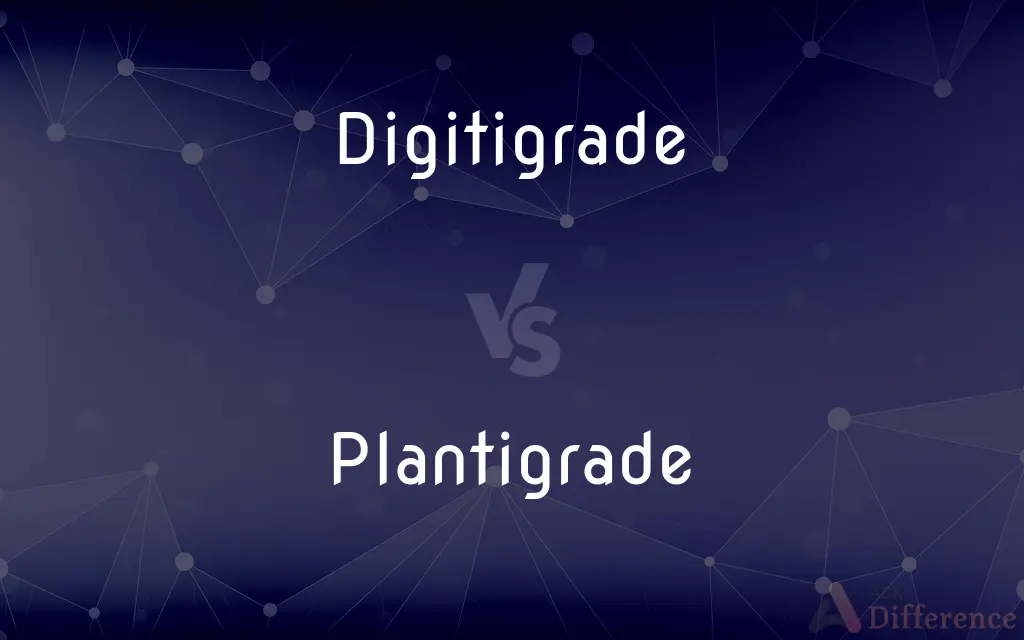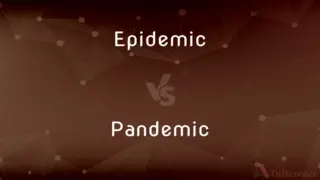Digitigrade vs. Plantigrade — What's the Difference?
By Tayyaba Rehman — Updated on October 27, 2023
Digitigrade locomotion involves walking on toes, common in animals like dogs and cats. Plantigrade locomotion means walking with the entire foot on the ground, as seen in humans and bears.

Difference Between Digitigrade and Plantigrade
Table of Contents
ADVERTISEMENT
Key Differences
Digitigrade animals walk on their toes, elevating their heels above the ground. This contrasts with plantigrade animals, which walk with their entire foot, including toes and heels, making contact with the ground. The digitigrade stance offers speed and stealth, while the plantigrade stance provides stability.
In digitigrade locomotion, less of the foot touches the ground, which allows for quick, agile movements. In contrast, plantigrade walkers have a larger surface area of the foot in contact with the ground, providing a more stable and sturdy stance. Digitigrade locomotion is often seen in predators, while plantigrade is common in omnivores and herbivores.
The skeletal structure of digitigrade animals includes elongated metatarsals and phalanges, which aid in their toe-walking gait. Plantigrade animals, on the other hand, have a skeletal structure that supports walking on the whole foot. This structural difference highlights the distinct evolutionary paths of digitigrade and plantigrade species.
The digitigrade posture is advantageous for animals needing speed and stealth, as it allows for more efficient and rapid movement. Plantigrade locomotion, however, provides more endurance and weight-bearing capacity, beneficial for animals that require long periods of standing or walking.
Digitigrade animals often have padded toes, which aid in silent movement, crucial for hunting. Plantigrade animals might have broader feet for better support and weight distribution. These physical adaptations reflect the different lifestyles and environmental needs of digitigrade and plantigrade animals.
ADVERTISEMENT
Comparison Chart
Part of Foot Used
Walks on toes.
Walks on entire foot.
Common Examples
Dogs, Cats.
Humans, Bears.
Locomotion Speed
Generally faster.
Generally slower.
Stealth
Often more stealthy.
Less emphasis on stealth.
Weight Distribution
Less foot surface touches ground.
Larger foot surface on ground.
Compare with Definitions
Digitigrade
Definition: Digitigrade animals have elongated metatarsals.
Example: The digitigrade structure of a cheetah contributes to its incredible speed.
Plantigrade
Plantigrade refers to walking with the whole foot on the ground.
Humans, being plantigrade, have their entire foot flat on the ground while walking.
Digitigrade
Definition: Digitigrade species often exhibit agility and quickness.
Example: The digitigrade agility of a leopard enables it to climb trees effortlessly.
Plantigrade
Plantigrade species often prioritize endurance over speed.
The plantigrade gait of an elephant allows it to travel long distances.
Digitigrade
Efinition: Digitigrade refers to walking on the toes with heels raised.
Example: Cats, being digitigrade, move silently with their toes touching the ground.
Plantigrade
Plantigrade animals have shorter metatarsals.
The plantigrade structure of a bear provides it stability while standing.
Digitigrade
Definition: Digitigrade locomotion is often seen in carnivorous mammals.
Example: The wolf's digitigrade stance allows it to chase prey efficiently.
Plantigrade
Plantigrade locomotion is common in omnivores and herbivores.
The plantigrade gait of a raccoon is evident as it scavenges for food.
Digitigrade
Definition: Digitigrade walkers usually have padded toes for silent movement.
Example: The fox, a digitigrade animal, can sneak up on its prey unnoticed.
Plantigrade
Plantigrade walkers have a broader foot for better support.
The wide, plantigrade feet of a beaver help it navigate both land and water.
Digitigrade
In terrestrial vertebrates, digitigrade () locomotion is walking or running on the toes (from the Latin digitus, 'finger', and gradior, 'walk'). A digitigrade animal is one that stands or walks with its toes (metatarsals) touching the ground, and the rest of its foot lifted.
Plantigrade
In terrestrial animals, plantigrade locomotion means walking with the toes and metatarsals flat on the ground. It is one of three forms of locomotion adopted by terrestrial mammals.
Digitigrade
Relating to an animal, such as a cat or dog, whose weight is borne on the toes.
Plantigrade
Walking with the entire sole of the foot on the ground, as humans, bears, raccoons, and rabbits do.
Digitigrade
(zoology) Of an animal: walking on the toes, putting the weight of the body mainly on the ball of the foot, with the back of the foot, or heel, raised.
Plantigrade
(zoology) Of an animal: walking with the entire sole of the foot on the ground.
Digitigrade
(zoology) Of feet or a manner of walking: of, resembling, or pertaining to that of a digitigrade animal.
Plantigrade
(zoology) A plantigrade animal; an animal that walks with the entire sole of the foot on the ground.
Digitigrade
Belonging to the Digitigrada of the taxonomic order Carnivora.
Plantigrade
Walking on the sole of the foot; pertaining to the plantigrades.
Digitigrade
A digitigrade animal; an animal that walks on its toes, such as a cat or a dog.
Plantigrade
A plantigrade animal, or one that walks or steps on the sole of the foot, as man, and the bears.
Digitigrade
Walking on the toes; - distinguished from plantigrade.
Plantigrade
(of mammals) walking on the whole sole of the foot
Digitigrade
An animal that walks on its toes, as the cat, lion, wolf, etc.; - distinguished from a plantigrade, which walks on the palm of the foot.
Digitigrade
(of mammals) walking on the toes with the posterior part of the foot raised
Common Curiosities
Can you name some digitigrade animals?
Dogs, cats, and most carnivorous mammals.
What is digitigrade locomotion?
Walking on the toes with the heel elevated.
Which animals are typically plantigrade?
Humans, bears, and many omnivorous mammals.
What is plantigrade locomotion?
Walking with the entire foot, including heel and toes, on the ground.
What are the advantages of being digitigrade?
Greater speed and agility, often with stealthier movement.
Do digitigrade animals have any disadvantages?
They can be less stable and have less endurance compared to plantigrade animals.
Why do some animals evolve to be plantigrade?
For stability, endurance, and weight-bearing capabilities.
Do digitigrade animals have a different skeletal structure?
Yes, they have elongated bones in their feet and often lack a functional heel.
Are all mammals either digitigrade or plantigrade?
No, some mammals like horses are unguligrade, walking on the tips of their toes.
Do digitigrade animals have special foot adaptations?
Yes, often padded toes and elongated metatarsals for agile movement.
Can plantigrade animals be fast runners?
Some can be, but they generally prioritize endurance over speed.
Can the locomotion of an animal change over its lifetime?
Generally, no. The locomotion style is fixed based on skeletal structure.
Are primates typically plantigrade?
Yes, most primates, including humans, are plantigrade.
Is plantigrade walking more energy-efficient?
Yes, it typically allows for more energy-efficient movement over long distances.
Is the choice of prey influenced by an animal’s locomotion type?
Indirectly, yes. Faster, digitigrade predators may chase quicker prey, while plantigrade animals might opt for slower-moving or stationary food sources.
Share Your Discovery

Previous Comparison
Epidemic vs. Pandemic
Next Comparison
Albuminuria vs. ProteinuriaAuthor Spotlight
Written by
Tayyaba RehmanTayyaba Rehman is a distinguished writer, currently serving as a primary contributor to askdifference.com. As a researcher in semantics and etymology, Tayyaba's passion for the complexity of languages and their distinctions has found a perfect home on the platform. Tayyaba delves into the intricacies of language, distinguishing between commonly confused words and phrases, thereby providing clarity for readers worldwide.















































